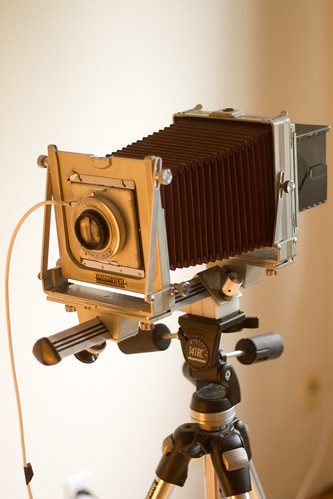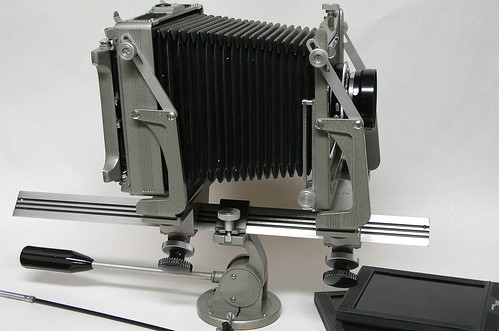Difference between revisions of "Graphic View cameras"
(→Graphic View II: added pool photo of this model) |
(added top photo of first version) |
||
| Line 1: | Line 1: | ||
| − | In 1940 or | + | {{Flickr_image |
| + | |image_source= http://www.flickr.com/photos/airchinapilot/4869830051/in/pool-camerawiki | ||
| + | |image= http://farm5.static.flickr.com/4077/4869830051_12ddf34e71.jpg | ||
| + | |image_align= right | ||
| + | |image_text= Graflex Graphic View (I) | ||
| + | |image_by= Keith Loh | ||
| + | |image_rights= wp | ||
| + | }} | ||
| + | In 1940 or 1941 Folmer [[Graflex]] followed the [[Corona View]] field-type camera with a full studio camera, the '''Graphic View,''' at a price of $97.50 USD<ref>[http://www.graflex.org/articles/graphic-view/GraphicView.html Gerald Pierce, graflex.org]</ref>. (Equivalent cost in 2008 would be $1,451.11.<ref>[http://data.bls.gov/cgi-bin/cpicalc.pl based on 1941/2008 CPI]</ref>) | ||
The camera is notable for its unusual "inverted V" three-sided monorail, which makes the camera nearly impossible to use without the original Graflex tripod head or a reasonable imitation. <ref>According to [http://www.waterbirch.com/photo/graphicview/graphicview.htm Michael Crowell,] the Bogen/Manfrotto 3299 quick release tripod adapter makes a reliable substitute.</ref> | The camera is notable for its unusual "inverted V" three-sided monorail, which makes the camera nearly impossible to use without the original Graflex tripod head or a reasonable imitation. <ref>According to [http://www.waterbirch.com/photo/graphicview/graphicview.htm Michael Crowell,] the Bogen/Manfrotto 3299 quick release tripod adapter makes a reliable substitute.</ref> | ||
===Movements=== | ===Movements=== | ||
| Line 16: | Line 24: | ||
The Graphic View was available with both the [[Graflex back]] and [["Graphic back"|spring back.]] [[Graflok back]]s are not original to the View Graphic, but have been retrofitted in some cases. | The Graphic View was available with both the [[Graflex back]] and [["Graphic back"|spring back.]] [[Graflok back]]s are not original to the View Graphic, but have been retrofitted in some cases. | ||
The View Graphic is easy to change from [[Landscape]] to [[Portrait]]: simply remove the back and re-attach in the desired orientation. | The View Graphic is easy to change from [[Landscape]] to [[Portrait]]: simply remove the back and re-attach in the desired orientation. | ||
| − | + | {{br}} | |
==Graphic View II== | ==Graphic View II== | ||
{{Flickr_image | {{Flickr_image | ||
Revision as of 03:19, 27 June 2011

|
| Graflex Graphic View (I) image by Keith Loh (Image rights) |
In 1940 or 1941 Folmer Graflex followed the Corona View field-type camera with a full studio camera, the Graphic View, at a price of $97.50 USD[1]. (Equivalent cost in 2008 would be $1,451.11.[2]) The camera is notable for its unusual "inverted V" three-sided monorail, which makes the camera nearly impossible to use without the original Graflex tripod head or a reasonable imitation. [3]
Contents
Movements
Movements are standard for a monorail-type view camera:
Front standard only:
- Rise and fall (3 5/8")
Both Standards:
- Shift (5/8")
- Tilt (26°)
- Swing (12°)
The View Graphic has a maximum bellows extension of 12", and a minimum of 3 1/2". The distinctive red bellows (made of some sort of coated canvas?) are not designed for removal or replacement; there were a few of the View Graphic cameras made with black bellows for the US Military (and released to consumers near the end of the View II run.)[4]
Backs
The Graphic View was available with both the Graflex back and spring back. Graflok backs are not original to the View Graphic, but have been retrofitted in some cases.
The View Graphic is easy to change from Landscape to Portrait: simply remove the back and re-attach in the desired orientation.
Graphic View II

|
| Graphic View II image by Mark O'Brien (Image rights) |
Graflex followed the successful Graphic View with the Graphic View II In 1949, making a number of slight changes:
- the View II has a slightly different "mottled silver" finish (to the original matte grey) on painted metal surfaces.
- the View II tilts the front standard on the optical axis of the lens, rather than from the base of the standard.
- The the View II has a maximum bellows extension of 16" (with a four-inch longer monorail.)
- After 1955, the View II was offered with the Graflok back as a standard feature.
Notes
- ↑ Gerald Pierce, graflex.org
- ↑ based on 1941/2008 CPI
- ↑ According to Michael Crowell, the Bogen/Manfrotto 3299 quick release tripod adapter makes a reliable substitute.
- ↑ Michael S. Crowell
Links
Gerald Pierce's Graphic View and Graphic View II pages on Graflewx.org
Michael S. Crowell's Graphic View II page.